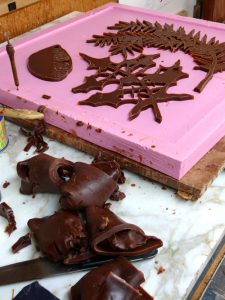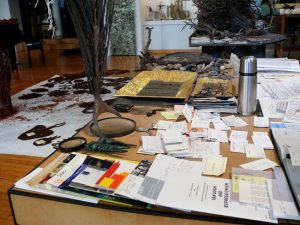Michele Oka Doner standing next to an Archival wax piece in progress.
Michele Oka Doner is justly known for her exquisitely beautiful public commissions such as the ‘Radiant Site’ at the Herald Square subway station and ‘A Walk on the Beach’, at the Miami International Airport, as well numerous pieces that have found their way into private collections the world over. Her governing passions are the strange and secret life forms all around us, found both on, and within land and water. These she renders in the rawest of raw materials. She is not without humor or lightness but she is unusually and gratifyingly serious. She seems to move about her life and her work as a kind of exotic and questing high priestess.
We interviewed her in her loft in SoHo where she lives with her husband, and, until they grew up, her two sons. She grew up in Miami, as a member of a privileged family, but she is one of those people who would have been what they are regardless of background.
Your father was mayor of Miami—what did that mean for you as a child?
It meant perfect manners and beautiful clothes and showing up on time. And when I was a teenager being told ‘you can’t smoke cigarettes in public. Your father’s the mayor.’
So did you smoke cigarettes in private?
I did when I was teenager. We all did. There was no tattooing and no piercing, it was about the worst thing you could do.
Packing a wax figure entitled ‘Angry Neptune’ for transport to the Foundry—to be cast in bronze. The sculpture is for Michele’s exhibit at the Marlborough Gallery, Chelsea in November 2008.
A rear view of the wax figure for the Marlborough Gallery, Chelsea show.
‘Reef Alive’ with ‘Burning Taras’ in the background.
‘Reef Alive.’
‘Titan,’ a cast bronze being completed for Michele’s 2008 show at Marlborough Gallery.
Do you think defiance is a necessary part of being an artist?
Well I think I would call it the ability to think for oneself as opposed to, you know, being part of the herd. Part of what art is, is finding the questions wonderfully baffling and trying to answer them in some profound and fundamental way. And those answers don’t come from a book or a teacher or a parent. They’re not answerable.
Do you think ultimately it is that separates art from religion: both dwell in the world of ideas but at the end of art you have ambiguity and at the end of religion you have certainty?
No, I think religion … there was a wonderful article in yesterday’s Science [section of] the Times, that said that religion evolved in the same way morality did, as a response to what was good for not only the ape, but he understood that all apes had to be cared for around him. It was beautifully written. I loved the way the concept of religion, which was what Martin Buber would call the ‘thou’ voice, the grooming of each other, and the watching out for each other as the ‘it’ voice, it’s the pragmatist. But religion is the dialogue we have with something transcendent. In art he also said, and I love this, he said other than humankind, art is the only other thing that has an intelligible voice, which is so beautiful … art and design are always in the service of an idea. They are not neutral.
Photos in the reading area. On the top right is John Coplan’s 1986 portrait of Michele with her two sons.
Beneath on the lower right is a 1966 photo of Michele during her Ann Arbor years.
Historical photos hang on the studio wall.
Waxes, seeds and wood in the studio.
An assemblage of tropical seeds on a Steuben 22-inch, glass, radiant disk designed by Michele.
The studio pet fish in a Steuben crystal bowl, part of Michele’s ‘Reef collection,’ 2005.
Waxes for Meijer gardens and sculpture park in Grand Rapids, Michigan.
They’re ready to be cast in bronze for a 2008 installation.
Ceramic work, 1964-1980.
Michele’s ‘Celestial Chair,’ 1990 sits next to a collection of amulet stones, shells and clay.
The stairway to the loft upstairs is in the background.
But with art, you start out with questions, and by the time you have made your art, you don’t end up with answers, only more questions.
I’m back to the figures, for five, six years now, which has just been a wonderful lifetime exploration and these figures are even more evocative because I met a woman named Nancy Voss who has what’s called the Voss Invertebrate Museum at the University of Miami. And inside these double doors, you come in, and there’s a woman in her seventies, with short cropped gray hair and a fabulous tan from a lifetime out trolling in the water and she has 175 000 objects in jars that she and her deceased husband had collected together. After I had said ‘oooh’ and ‘aah’ and ‘can I come back and photograph this?’ she said so poignantly: ‘yes, it’s so wonderful but it is all going to be gone before we even have a chance to study it.’ So instead of looking at the coral as beautiful for my figures, I made ‘Angry Neptune’ and the power of that piece, and the force of it is so undeniable. So he is in service of my response to Nancy Voss. Here’s something that is political, ethical, visual … a lifetime’s study of the ocean.
I am wondering what you think of intelligent design?
Oh there’s so much great truth in how things divide and replicate themselves. There’s such a life force, whatever name anybody gives it. It’s undeniable. And there is magic. It’s why we all stop when we see the lightening … to hear the thunder, the dialogue in a way between electricity and violence.
Above: Studio floor with healing plant photo for a proposal drawing for Newark, N.J. Cancer Center installation in 2008.
Looking down to the library section featuring the history of design and books on architecture.
A table filled with waxes and small bronzes stands in the foreground. In the background, the library.
A view through the library into the interior workspace.
| But we do have a tendency to ascribe order to things after the fact.
Yes, we do try to make order of this streak of our lives. We need to. Order comes from ritual. And the order I have ceremonially established a pattern that gives me order. I love the ritual of everyday life. Can you describe that? Soap. Soap is amazing, you know. And I like washing my hands in the morning. And I like the same ritual everyday. And I like turning on fire. I don’t have electric, I always have gas for cooking. I cook a breakfast every day and I pay attention to it. I have grains. I like raw materials, even with my food. I pay attention to where the coffee beans come from and I grind them. It takes time but after that I’m ready for my day. So you’re very aware all the time. A lot of people go through life never really feeling awake. That’s the wonderful poem: Tell me not in mournful numbers/Life is but an empty dream/For the soul is dead that slumbers. [A Psalm of Life by HenryWadsworth Longfellow] … a sleeping soul! That poem was written a long time ago – there’s always been people who don’t wake up. |
|||
|
|
|||
| Your work is so tactile. Do you go around touching things all the time?
Sure. And I let people touch everything here. This table I built about 35 years ago and it has fossilized segmented worms, and the circles are part of a Crinoid, which is a sea lily. You must love the water. I love the water. I mean we talk about Mother Earth but I feel like this is my mother. |
Prototypes, including silver palm vases for Christofle, a maquette for Newark Penn Station and magnifiers on the studio table.
Collected prototypes for use in the studio.
A plan for the Miami International Airport.
Melting wax, a daily activity!
Cutting waxes for the Meijer garden and sculpture center in Grand Rapids, M.I.
Prototype wax cup to be cast in silver.
Breaking wax to melt.
|
Waxes for texturing figures.
Do you scuba dive?
I don’t scuba dive. I snorkel but even then, I don’t like equipment. I’m a barefoot girl. And so if I walk what I call the littoral zone, right where land meets water, I find that the most interesting place in the world.
A barefoot girl. So now I have a story to tell you. I was on the subway some months ago and it was bitter cold. There was this woman sitting opposite me and I couldn’t take my eyes off her, her clothes, her jewelry, which looked like a sparkling, fossilized sea urchin stretched around her wrist. She wore a big black cloak and her feet were bare, clad only in flip flops … and it was so cold, then she smiled at me, and it was you.
I know why. I was coming back from my pedicure. [laughs delightedly]…
The Doner studio archives, and sponges for additional reefs.
Interior room of studio with iron anvil and wood.
‘Amulets’ from an exhibition at the Diane Brown Gallery in New York City, c. 1980s.
Wax working tools.
A poster from an exhibition at the Detroit Institute of Arts, 1977, hangs above the studio sink.
A view of the interior studio.
I was wondering: ‘Is she one of those mad people or is she an artist?’
No, I’m one of those mad people.
So what is your favorite nail polish?
I had one, Helena Rubenstein, for years: Absolute Bliss.
Packing figures for delivery to the Foundry.
The three-hour packing process comes to a close.
Packing complete!
Michele’s desk. Her Thermos is filled with hot water and fresh ginger.
Entrance totems.
— Sian Ballen and Lesley Hauge; photographs by Jeffrey Hirsch











































